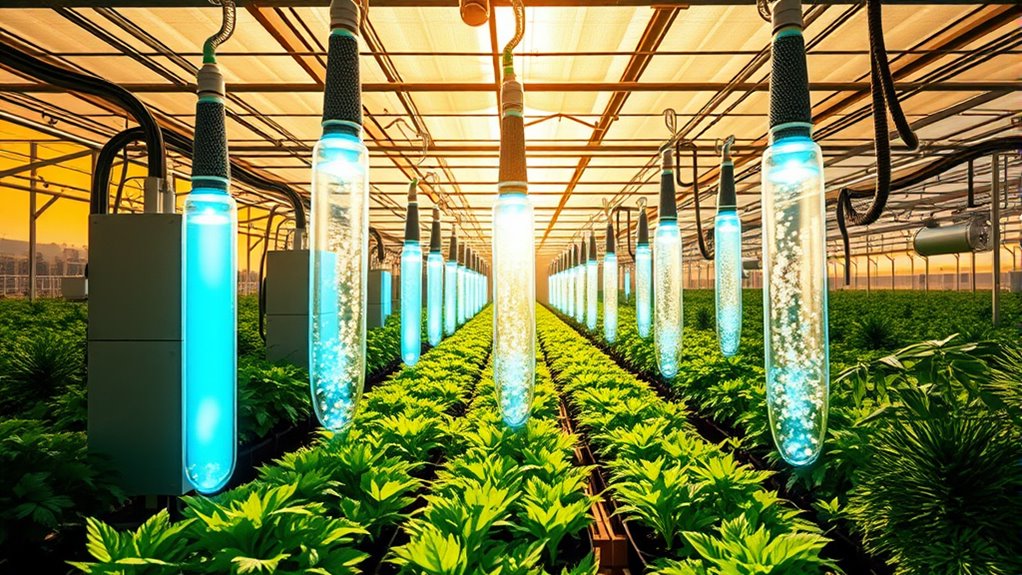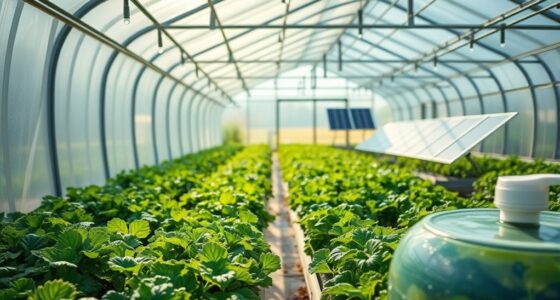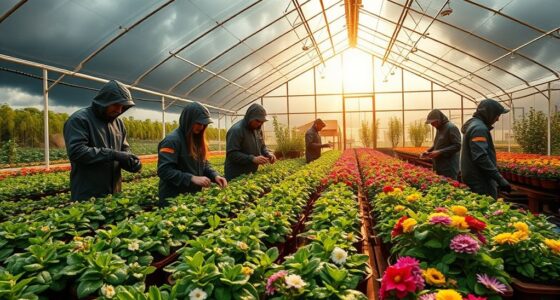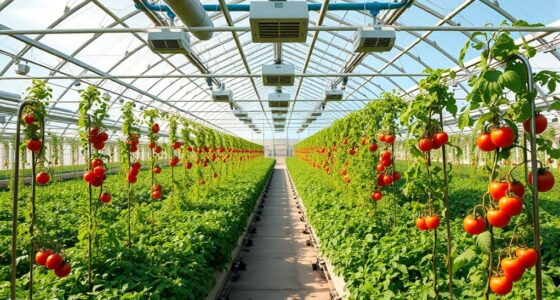Implementing carbon capture in greenhouses helps you boost plant growth while reducing emissions. By enriching the environment with concentrated CO₂, you enhance photosynthesis and increase yields. Using advanced systems and renewable energy, you can also capture excess CO₂ and convert organic waste into clean energy through BECCS. This approach turns your greenhouse into a carbon sink, supporting sustainability and productivity. Keep exploring to discover how these innovative strategies can transform your greenhouse operations.
Key Takeaways
- Integrating CO₂ enrichment systems enhances photosynthesis, boosting plant growth and yield.
- Capturing excess CO₂ from energy processes reduces greenhouse gas emissions in greenhouse operations.
- Using renewable energy-powered systems ensures sustainable carbon capture and minimizes environmental impact.
- Automating environmental controls optimizes conditions for plant health and maximizes carbon sequestration.
- Bioenergy with carbon capture (BECCS) provides renewable energy while actively removing greenhouse gases.
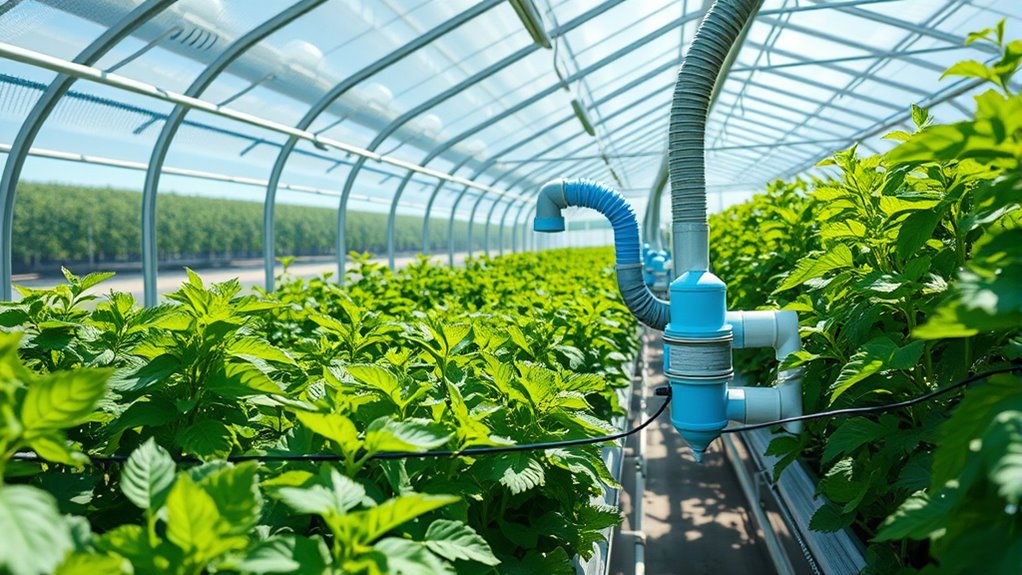
Greenhouses have traditionally focused on creating ideal conditions for plant growth, but recent innovations are turning them into tools for environmental sustainability through carbon capture. By integrating advanced techniques, you can enhance photosynthesis efficiency within your greenhouse, leading to healthier plants and higher yields. When plants absorb carbon dioxide during photosynthesis, they grow more robustly and produce better quality produce. Optimizing the internal environment not only benefits plant growth but also plays a critical role in greenhouse gas mitigation. You can implement systems that capture excess CO₂ from the atmosphere or energy processes, reducing your overall carbon footprint.
Transform your greenhouse into a sustainable carbon sink by optimizing conditions and capturing excess CO₂ for healthier plants.
One effective strategy involves incorporating CO₂ enrichment systems that provide plants with concentrated carbon dioxide, boosting photosynthesis efficiency. When you supply your plants with higher levels of CO₂, they utilize it more effectively, accelerating growth and increasing biomass. This process makes your greenhouse more productive while simultaneously capturing and utilizing carbon that would otherwise escape into the atmosphere. Such systems can be powered by renewable energy sources, ensuring that your efforts for greenhouse gas mitigation are sustainable and environmentally friendly.
Additionally, you can explore the integration of bioenergy with carbon capture (BECCS), where organic waste or biomass is used to generate energy, and the resulting CO₂ emissions are captured and stored. This approach not only reduces greenhouse gases in the atmosphere but also provides a renewable energy source for your greenhouse operations. By adopting these innovations, you’re effectively turning your greenhouse into a carbon sink, actively removing and sequestering greenhouse gases while supporting ideal plant growth.
Furthermore, advances in controlled environment agriculture allow you to fine-tune parameters such as temperature, humidity, and light, creating the perfect setting for both plant health and carbon capture efficiency. Automated systems can monitor and adjust conditions in real-time, ensuring maximum photosynthesis efficiency and minimal emissions. These technological improvements help you meet sustainability goals and reduce reliance on fossil fuels, ultimately lowering greenhouse gas emissions associated with traditional farming practices. Incorporating advanced climate control systems can significantly enhance both plant productivity and environmental benefits.
Frequently Asked Questions
How Cost-Effective Is Greenhouse Carbon Capture Technology?
You might wonder about the economic feasibility of greenhouse carbon capture technology. Currently, costs vary depending on the technology and scale, but technological advancements are making it more affordable. While initial investments can be high, the long-term benefits, such as reduced emissions and improved crop yields, often justify the expense. As innovation continues, you can expect carbon capture in greenhouses to become increasingly cost-effective and accessible for sustainable farming.
What Types of Crops Benefit Most From This Method?
Think of your greenhouse as a symphony, where each crop plays a essential note. Leafy greens like lettuce and spinach thrive, gaining improved plant health and higher crop yield through carbon capture. Fruit-bearing plants like tomatoes and peppers also benefit, as enhanced CO2 levels boost growth. This method helps all these crops perform better, making your greenhouse more productive and sustainable by nurturing healthier plants and increasing yields.
Are There Any Health Risks Associated With Captured CO2?
You might wonder about health concerns related to CO2 exposure. While high levels of captured CO2 in greenhouses are generally safe for plants, prolonged or intense exposure can cause health risks like headaches or dizziness. As a worker or visitor, you should guarantee proper ventilation and monitoring to minimize CO2 exposure. When managed correctly, the potential health risks are low, making it a safe method for greenhouse operations.
How Scalable Is Greenhouse Carbon Capture for Large Farms?
Scaling challenges and infrastructure requirements pose significant hurdles for greenhouse carbon capture on large farms. You’ll need substantial investments in equipment, space, and energy to expand these systems effectively. While the technology is promising, its scalability depends on overcoming these obstacles, integrating efficient capture methods, and ensuring cost-effectiveness. Ultimately, addressing these factors will determine whether large farms can adopt carbon capture at a meaningful, widespread level.
What Are the Environmental Impacts of the Capture Process?
You might wonder about the environmental impacts of carbon capture processes. They can positively influence the carbon cycle by reducing CO2 emissions, which helps lower the atmospheric impact and combat climate change. However, some methods may require energy, potentially producing additional emissions if not sourced sustainably. Overall, careful implementation can minimize negative effects, making greenhouse carbon capture a promising tool for balancing agricultural growth with environmental health.
Conclusion
So, here you are, using clever carbon capture tricks to boost your greenhouse’s growth while sneaking around the pesky emissions. Ironically, while you’re busy trapping CO₂ to help plants thrive, you’re also playing a part in tackling climate change—without even breaking a sweat. Who knew that the secret to greener thumbs could also be a cheeky way to save the planet? Turns out, a little innovation can go a long way—just like your greenhouse ambitions.
